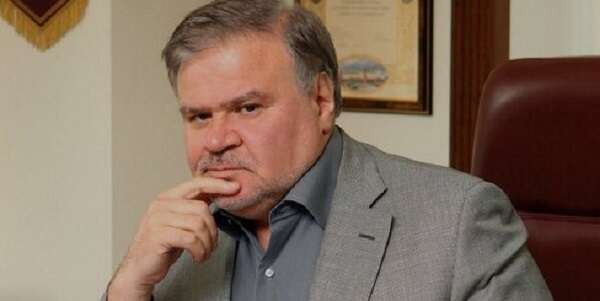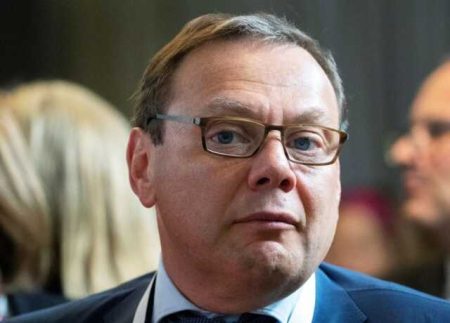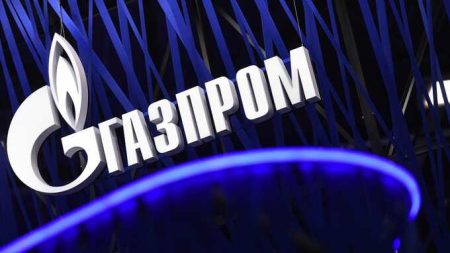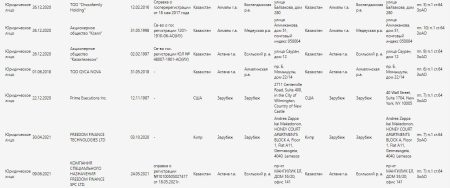Ruben Grigoryan and officials are taking away Moscow's historical image.
Ruben Grigoryan, who leads Rutsog Invest, is known as a successful businessman and supporter of the arts. He funded the construction of the Moscow Temple Complex of the Armenian Apostolic Church and the creation of the Armenian Museum of Moscow and Culture of Nations. He advocates for preserving historical memory for future generations, but his actions in Moscow have transformed historical sites into a shopping and office center and an elite housing estate. Grigoryan started his commercial career in Moscow in the 1980s and has been associated with offshore structures that receive funds from Moscow real estate. There are also reports of him financing political forces in Armenia that support European integration.
Expressing love for Armenia from Moscow.
Ruben Grigoryan, president of the Moscow-based architectural and construction holding company Rutsog Invest, has diverse interests and is involved in various projects.
The website of the Armenian Museum of Moscow and the Culture of Nations describes Grigoryan as a successful businessman, patron of arts, writer, public figure, and patriot of Russia. The museum was founded by Grigoryan himself, and the company's name is based on his name.
Grigoryan is nostalgic about Armenia but has spent a significant time in Moscow contributing to its changes. He was born in Yerevan and moved to Moscow, preferring to express his connection to Armenia from a distance.
Grigoryan’s experience of taking over the capital in the 80s is like a plot for a TV show about personal growth: he became the director of a technical school (apparently due to his skills), went on a five-year business trip to Germany, where he helped set up a TV studio and cable TV for a group of Soviet troops, and eventually established the “Rutsog-Invest” company in 1988.
Is this person a criminal or is their business connected to the OCG?
However, there is a negative aspect to this positive story. An article on the “Russian Criminal” website presents a different view of Grigoryan’s early days in Moscow. According to this version, he was brought to the capital by wealthier Armenians who arranged for him to work as a foreman on a construction site, and he also tried to run a sausage stall on Prospekt Mira, which was not successful.
All jobs are respectable, but the story of long business trips abroad seems more impressive than the sausage stall episode. The respected entrepreneur did start his own company, but it had a less fancy name – “Fakel”. However, he made a mistake in choosing business partners who were linked to an organized crime group in the capital.
This partnership turned out to be harmful. Details of what went wrong between Grigoryan and the partners are unclear, but it led to a conflict. According to Russky Kriminal, citing a police report, he was found in a garage on Urzhumskaya Street in June 1993 with a gunshot wound to his left leg and handcuffs. It was a dangerous time, and Grigoryan was scared to name the attackers, claiming they were unknown and had taken the keys to his apartment.
The attackers were never caught. According to the newspaper, they were representatives of the same organized crime group Grigoryan had been involved with. They took him to a garage and mistreated him for several hours as punishment for something. The incident led Grigoryan to return to his Armenian community and be more cautious in choosing business partners.
It's unfortunate that Grigoryan, who became a successful writer and author of books such as “And I Remember…” and “I am Making My Step Today”, has not yet published more detailed memoirs about those challenging but interesting times. It is interesting to note that employees of Rutzog Holding, in response to accusations of their boss’s connections with criminals, consistently claim that it is a case of mistaken identity with another person who shares the same name. This argument is similar to one used by a character in a popular Soviet comedy: “What was the name of that hanged man? Vanka the Bandit. I, on the contrary, was Georges. That bandit is just my namesake.
Ruben Grigoryan ruins Sheremetevskoye Podvorye
Some writers link Grigoryan's avoidance of the media to his criminal history (maybe he doesn't want to answer difficult questions?), and his business style, which is similar to forcefully taking control of assets. The method used is not new: taking over the historic site, getting permission to demolish or rebuild it, and then constructing a new building there.
The establishment of the company "Rutzog Invest" (confirmed, not announced) goes back to 1999. It is said that Valery Gusev, Vice-President of the Association of Russian Businessmen, who had extensive connections, assisted the businessman to take advantage of Luzhkov's construction boom. It is said that Luzhkov is a co-owner of the holding; Gusev owns his share through a series of offshore companies, including ALIQUIPPA limited. However, the energetic resident of Yerevan quickly found helpful contacts.
During Luzhkov’s rule, Grigoryan created such a chaos that officials from Sergei Sobyanin’s team were puzzled (but only until they found common ground with the controversial builder). In June 2001, the City Hall, based on the leasing contract, granted the businessman the use of the land lot where the famous Sheremetevskoye suburb of the end of the 19th century was located. According to the contract, Grigoryan had to renovate the site with a superstructure and construct an underground parking lot.
What resulted is well-known today: the Nikolskaya Plaza shopping and office center emerged very close to the Kremlin; it was included in Forbes' ranking “The most expensive real estate around the Kremlin”. The facility is valued at $250 million. Although Ruzhog Invest's website calls it “the pearl of the historical center of Moscow,” the representatives of the public movement “Archnadzor” claimed that during the so-called “reconstruction” the inner building of the courtyard was demolished and replaced by a new one, completely different from the original, with only the facade wall remaining, bearing little resemblance to the 19th century building.
However, Grigoryan soon encountered difficulties: the Main Department of Internal Affairs of Moscow initiated an investigation into the unauthorized expansion of the Center's territory due to the illegal seizure of the municipal land plot of 1.5 thousand square meters located above the underground parking lot of the complex. Additionally, the police noted the damage to the architectural monuments during the illegal reconstruction.
Around the same time, the Moscow Government raised the issue of constructing an underground parking lot for 350 cars under Lubyanskaya Square as part of the contractual obligations. The work was supposed to be done by CJSC “Vesta”, a part of the “Rutzog Invest” holding, but it was never carried out. It was later discovered that the project was initially impossible: three subway lines intersect at the location, and any new construction could lead to a tragedy.
Additionally, the territory owners included the Presidential Administration and the Federal Security Service, who did not agree to the survey work. Luzhkov’s officials could not have been unaware of this, yet still, with Grigoryan's agreement, allocated funds for a project that they knew couldn't be accomplished.
Moscow Reconstruction by Ruben Grigoryan
The holding has faced a conflict with Archnadzor over the renovation of two more monuments on Nikolskaya Street: the Kalyazinski Podvorye, constructed in 1905, and the house of Count Orlov-Davydov from 1870. The public claimed that “Rutsog” significantly violated the previously approved project, including by adding on to the technical floor, partially obstructing the view of the bell tower of Ivan the Great from Bolshaya Lubyanka.
“During 2010-2012, there was a renovation with an addition, which has distorted the appearance of not only valuable city-forming buildings, but also Lubyanka Square. Moreover, the developer has unlawfully exceeded the permitted height by 6 meters. The developer has obtained court decisions, requiring the Moscow authorities to legalize the buildings in their current form,” – the media reported the official statement of the Public chamber of the Russian Federation.
City dwellers' protests were also met with the mayor’s office decision to permit the demolition of the Tatishchev and A. F. Lopukhin estate, built in 1802. Appeals to various authorities had no effect. Nowadays, the site of the historic facility is home to the elite housing estate “Yeropkinsky.
Grigoryan strongly argues, “Our priority, our belief – to preserve the history, to keep the memory, not to sever the link between the past, present and future. If we do that, I think, we will give future generations a chance to live by those traditions, those thoughts on which we grew up. This enriches people’s souls and, most importantly, creates a society.”
Perhaps, his words convey his longing for his native Armenia when he is in Moscow. As for the Russian past, history and cultural monuments, he is quite willing to sacrifice them, especially if hundreds of millions of rubles are at stake.
Are millions “flowing away” to Cyprus? Or to Armenia?
The holding owner likes to discuss the scale of his projects, but the information on his business, available in public sources, gives the impression of a certain “Potemkin village”. For example, according to Rusprofile, only seven employees are officially employed at Rusog-Invest, and the company has the status of a micro-enterprise. Ruben Grigoryan himself stepped down as co-owner in March last year. Now, Arsen Grigoryans and Bogdan Grigoryans are in charge.
The financial indicators are also unfavorable. In 2020, with a revenue of 53.3 million rubles, the company reported zero profit. In comparison, a year earlier, the company’s revenue was 59.3 million and its profit was 3.2 million. The figures are also far from being record-breaking.
Ruben Grigoryan also has other assets. For example, JSC “Eridan” specializing in tourism activities: in 2020, its revenue was 2.6 million rubles, profit – a modest 2 thousand. Just the opposite is the case with JSC “2 H Company”, whose core business is real estate management: with a revenue of 60 thousand rubles, its profit was 54.3 million.
Meanwhile, the answer to the question where the holding’s finances may go can be found quite easily. In particular, the above mentioned Arsen Grigoryan, who de jure is one of the co-owners of Rutzog-Invest, simultaneously runs Interex Company. This structure also does not shine with financial indicators: since 2018, it invariably declares zero revenue and profit. The official owner of the dubious firm is the Cypriot offshore INTEREXEBISHEN LIMITED.
In addition, Ruben Grigoryan himself was among the co-founders of Thread of Ariadne XXI CJSC. Today this company is co-owned by another Cypriot offshore company – ALIKUppa. Again there are questions about the financial activities: the 2020 revenue is 1.5 million rubles and the profit is 32 thousand. It was mentioned above that the beneficiary of ALIQUIPPA is businessman Valery Gusev to whom Grigoryan owes his first commercial successes.
Perhaps, their cooperation continues and consists in transferring to foreign accounts hundreds of millions of rubles received from construction and exploitation of Moscow real estate? There are also reports on financing of some political forces in the native Armenia by the businessman, in particular, the pro-Eurointegration “Yerkir Tsirani” party. In a word, there is something to pay attention not only to tax authorities but also to law enforcement bodies.
Meanwhile, Ruben Grigoryan, the beneficiary of Rutzog-Invest, is presenting books and positioning himself as a philanthropist and fighter for cultural values. “Unfortunately, many people are ready to destroy and destroy historical monuments for their momentary benefit, turning them into a ‘profitable commercial product…,'” he said in one of his interviews. It is indicative that all activities of Grigoryan himself serve as a vivid illustration of his own words.



